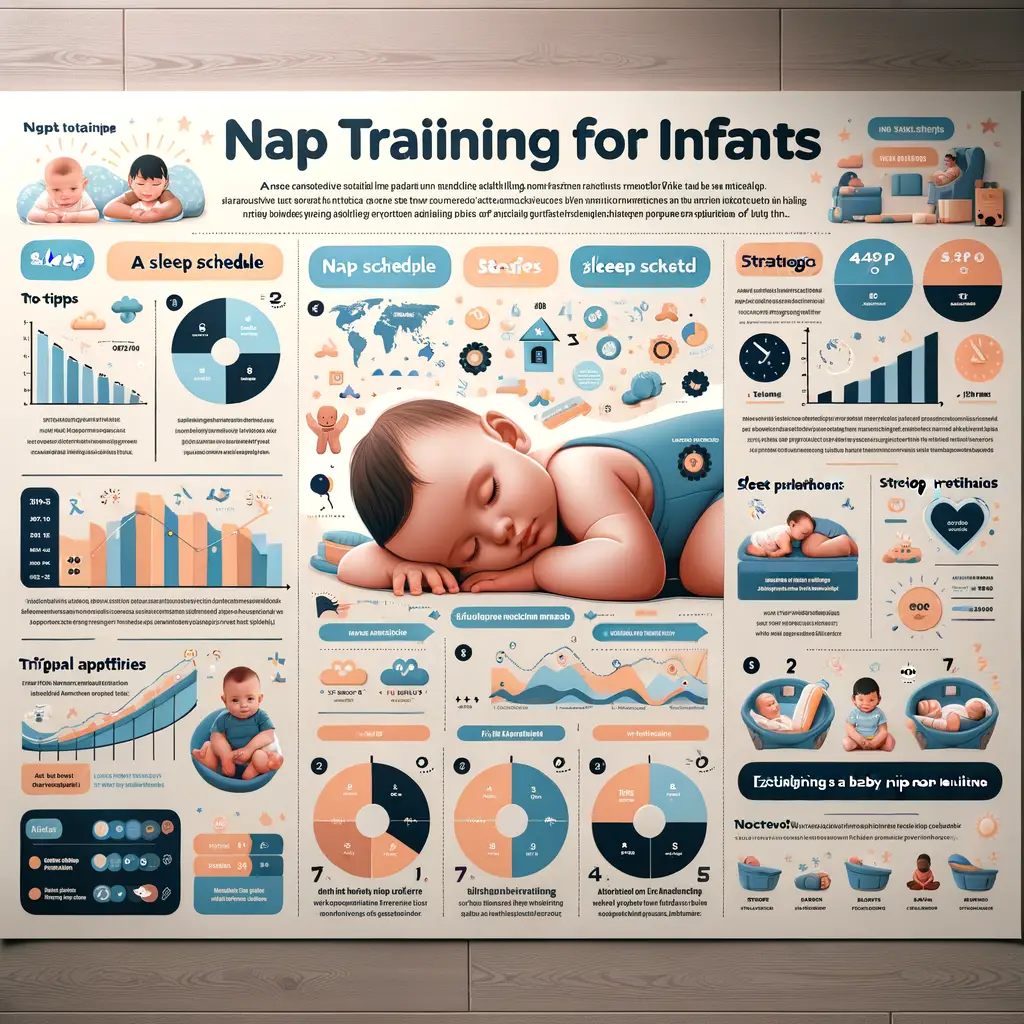Introduction to Nap Training for Babies
Welcome to our comprehensive guide on nap training for babies. This introductory section will provide you with a basic understanding of the importance of a baby sleep schedule and the benefits of starting nap training early. Let’s delve into these topics.
Importance of Baby Sleep Schedule
Establishing a consistent sleep schedule for your baby is crucial for several reasons. Firstly, it helps regulate your baby’s internal body clock, also known as the circadian rhythm, which can lead to better sleep quality and duration. Secondly, a predictable sleep schedule can make your life as a parent easier, as you’ll know when you’ll have time for other tasks or a bit of rest. Lastly, a regular sleep schedule can contribute to your baby’s overall health and development. According to a study from Pediatrics, babies who follow a consistent sleep schedule have improved cognitive and physical development compared to those with irregular sleep patterns.
Benefits of Starting Nap Training Early
Starting nap training early has several benefits. For one, it can help your baby develop good sleep habits that can last a lifetime. Early nap training can also reduce the risk of sleep problems later in life, such as insomnia. Moreover, babies who are nap trained early are often better at self-soothing, which can lead to more restful sleep for both the baby and the parents. A study published in the Journal of Sleep Research showed that babies who started nap training before six months of age had longer, more consistent sleep patterns than those who started later.
As we move forward in this guide, we will delve deeper into understanding infant sleep patterns, when and how to start nap training, establishing a baby nap routine, different nap training methods, tips, and common challenges. Stay tuned to become a master in nap training for your baby.
Understanding Infant Sleep Patterns
Understanding how your infant sleeps can be a key factor in successful nap training. Infants have unique sleep patterns that evolve as they grow. This section will delve into the stages of sleep in infants and how these patterns change over time.
Stages of Sleep in Infants
Infants, like adults, cycle through different stages of sleep. However, their sleep cycles are shorter and more varied. Here are the main stages:
Active Sleep: This is similar to REM (Rapid Eye Movement) sleep in adults, where dreams occur. Infants spend about half of their sleep time in this stage.
Quiet Sleep: This stage is akin to deep sleep in adults. The baby’s body is still, and breathing is slow and regular.
Transitional Sleep: This is a brief stage where the baby shifts from active to quiet sleep or vice versa.
Understanding these stages can help you recognize when your baby is in a light or deep sleep, aiding in nap training.
How Infant Sleep Patterns Change Over Time
As your baby grows, their sleep patterns will change. Here’s a general timeline:
| Age | Sleep Pattern |
|---|---|
| Newborn | Newborns sleep in short bursts of 2-3 hours, day and night. |
| 3-6 months | Infants start to sleep longer at night, but still require several naps during the day. |
| 6-12 months | Most babies sleep through the night and take 1-2 naps during the day. |
Remember, every baby is unique and may not follow this exact timeline. It’s important to observe your baby’s individual sleep habits.
Understanding your baby’s sleep patterns is the first step towards successful nap training. In the following sections, we’ll discuss when to start nap training and how to establish a routine.
When to Start Nap Training
Knowing when to start nap training is crucial for your baby’s development and your peace of mind. It’s important to remember that every baby is unique, and there’s no one-size-fits-all approach. However, there are some common signs and age ranges to help guide you.
Signs Your Baby is Ready for Nap Training
Recognizing the signs that your baby is ready for nap training can be a game-changer. Here are some key indicators:
Your baby is between 4 and 6 months old. This is typically when babies start to develop a regular sleep-wake cycle.
Your baby is showing signs of self-soothing, such as sucking on their hand or a pacifier.
Your baby is able to fall asleep independently at night.
Your baby is waking up frequently during naps or having short naps.
Remember, these are just guidelines. Every child is different, and you know your baby best. If you’re unsure, consult with your pediatrician.
Common Age Ranges for Starting Nap Training
The age at which you start nap training can vary greatly depending on your baby’s individual needs and development. However, most experts agree on the following age ranges:
| Age Range | Typical Sleep Behavior |
|---|---|
| 0-3 months | Babies this age typically sleep and wake frequently throughout the day and night. |
| 4-6 months | This is often the ideal time to start nap training, as babies start to develop a more regular sleep-wake cycle. |
| 6-9 months | By this age, most babies are ready for a more structured nap schedule. |
Again, these are general guidelines. Always consider your baby’s individual needs and consult with your pediatrician if you have any concerns. 
How to Train Baby for Naps
Training your baby for naps is a crucial part of their development. It not only ensures they get the rest they need, but also helps establish a routine that can make your life easier. There are several techniques you can use to train your baby for naps, each with its own set of steps and benefits.
Nap Training Techniques
Here are three popular nap training techniques that you can try with your baby:
Gradual Retreat Method
This method involves gradually reducing your presence in your baby’s room during nap time. Start by sitting next to their crib while they fall asleep. Each day, move a little further away until you’re out of the room. This helps your baby learn to fall asleep without your immediate presence. According to a Wikipedia article, this method is gentle and effective, but it requires patience.
Pick Up/Put Down Method
With the Pick Up/Put Down method, you pick up your baby when they start to fuss and put them down as soon as they calm down. This reassures your baby that you’re there for them, but also teaches them that they can fall asleep on their own. This method can be a bit tiring, but it’s often very effective.
Fading Method
The Fading method involves gradually reducing the amount of help you give your baby to fall asleep. For example, if you usually rock your baby to sleep, you might start by rocking less and less each day until your baby can fall asleep without rocking. This method can be a good choice if your baby is used to a lot of help falling asleep and you want to change that gently and gradually.
Remember, every baby is unique and what works for one might not work for another. It might take some trial and error to find the method that works best for your baby. But with patience and consistency, you can help your baby learn to nap well.
Establishing Baby Nap Routine
Establishing a consistent nap routine for your baby is crucial for their overall health and development. It can also provide much-needed breaks for parents. This process involves creating a consistent sleep environment, setting a regular nap schedule, and using soothing pre-nap routines. Let’s delve into these steps.
1. Creating a Consistent Sleep Environment
A consistent sleep environment is key to a successful nap routine. This means ensuring the room is quiet, dark, and at a comfortable temperature. Using a white noise machine can help drown out any disruptive noises. It’s also important to make sure your baby’s crib or bed is comfortable and safe. According to the American Academy of Pediatrics, a firm mattress covered with a tight-fitting crib sheet is recommended to reduce the risk of SIDS.
2. Setting a Regular Nap Schedule
Setting a regular nap schedule is another crucial step. Babies thrive on routine, and a predictable schedule can help signal to your baby that it’s time to sleep. While the exact timing can vary depending on your baby’s age and individual needs, most babies need 2-3 naps per day. It’s important to watch for signs of sleepiness, such as rubbing eyes or yawning, and put your baby down for a nap before they become overtired.
3. Using Soothing Pre-Nap Routines
Finally, using soothing pre-nap routines can help ease your baby into sleep. This could include activities like reading a book, singing a lullaby, or giving your baby a gentle massage. These routines can serve as a signal to your baby that it’s time to sleep, helping them transition from playtime to naptime. Remember, consistency is key – try to do the same activities in the same order before each nap.
In conclusion, establishing a baby nap routine involves creating a consistent sleep environment, setting a regular nap schedule, and using soothing pre-nap routines. By following these steps, you can help ensure your baby gets the rest they need for healthy growth and development.
Infant Nap Training Methods
Training your infant to nap can be a challenging task, but with the right methods, it can be made easier. Here, we will explore three effective nap training techniques that have been proven successful in various case studies.
Case Study: Successful Nap Training Techniques
Let’s delve into the details of each method and understand how they can be implemented for successful nap training.
Method 1: Controlled Crying
This method, also known as the Ferber method, involves letting your baby cry for a predetermined amount of time before offering comfort. The goal is to help your baby learn to self-soothe and fall asleep on their own. A study published in Pediatrics found that babies who underwent this method had no signs of stress or negative effects and had improved sleep.
Method 2: No Tears Method
The No Tears Method focuses on comforting the baby immediately when they start to cry. This method encourages a strong bond between parent and child and promotes a positive association with sleep. According to a study in the Journal of Developmental & Behavioral Pediatrics, this method can lead to longer sleep durations and less night waking.
Method 3: Chair Method
The Chair Method involves sitting in a chair next to your baby’s crib until they fall asleep. Gradually, you move the chair further away until you’re out of the room. This method can be less stressful for the baby as they can see you while falling asleep. A study in the Journal of Clinical Sleep Medicine found that this method can be effective in reducing the time it takes for a baby to fall asleep.
Remember, every baby is unique and what works for one might not work for another. It’s important to try different methods and see what works best for your baby. Always consult with a healthcare professional if you have any concerns about your baby’s sleep patterns.
Baby Nap Training Tips
As parents, we often face challenges when it comes to baby nap training. Here are some useful tips to help you navigate through these challenges and ensure your baby gets the rest they need.
Dealing with Nap Resistance
Many babies resist nap time, especially when they’re experiencing new things and their curiosity is at its peak. It’s important to maintain a consistent nap schedule and create a calm, soothing environment to help your baby relax. Use soft music, dim lights, and gentle rocking to signal to your baby that it’s time to sleep. Remember, patience is key. Studies show that consistency and routine can help reduce nap resistance over time.
Adjusting Nap Schedules as Baby Grows
As your baby grows, their sleep needs change. Newborns sleep a lot, often in short bursts. As they grow older, they start to need fewer but longer naps. It’s important to adjust your baby’s nap schedule to match their developmental stage. For example, a 6-month-old baby typically needs two naps a day, while a 2-year-old toddler might only need one. Keep an eye on your baby’s sleep cues and adjust their nap schedule accordingly.
Handling Nap Transitions
Transitioning from multiple naps to fewer can be a challenging time for both baby and parents. It’s important to make these transitions gradually. Start by slowly reducing the length of the nap you’re trying to phase out, while slightly increasing the length of the other naps. This gradual shift can help your baby adjust to the new nap schedule without causing too much disruption. Remember, every baby is different and it’s important to follow your baby’s cues when making these transitions.
In conclusion, baby nap training can be a challenging process, but with patience, consistency, and a good understanding of your baby’s sleep needs, you can help your baby develop healthy sleep habits that will benefit them for years to come.
Common Challenges in Nap Training
As you embark on the journey of nap training your baby, it’s important to be aware of the common challenges you may encounter. Understanding these challenges can help you be better prepared to address them. Let’s explore three common issues: short naps, nap refusal, and early waking.
Short Naps
Short naps are a common challenge in nap training. Babies often have difficulty consolidating their sleep during the day, leading to naps that are shorter than the ideal 1-2 hours. This can be due to various factors such as an overstimulating sleep environment, hunger, or not being tired enough. To address this, ensure your baby’s sleep environment is calm and soothing, and that they have had enough to eat before nap time. It may also help to adjust their awake time to ensure they are sufficiently tired when it’s time to nap.
Nap Refusal
Another common challenge is nap refusal. This can be particularly frustrating as it can disrupt your baby’s sleep schedule and leave them overtired. Nap refusal can be due to reasons such as being overtired, under-tired, or experiencing a sleep regression. To overcome this, try adjusting your baby’s awake times to ensure they are not too tired or too awake when it’s time to nap. If your baby is going through a sleep regression, be patient and consistent with your nap routine, as this phase will pass.
Early Waking
The third common challenge is early waking. This is when your baby wakes up too early from their nap before they have had enough sleep. Early waking can be due to factors such as hunger, discomfort, or being too awake when put down for a nap. To address this, ensure your baby is well-fed and comfortable before nap time, and that they are sufficiently tired when put down to sleep.
Remember, every baby is unique and what works for one may not work for another. The key is to be patient, flexible, and consistent in your approach. With time and practice, your baby will learn to nap well.
Conclusion: Mastering Nap Training
As we wrap up our comprehensive guide on nap training, it’s important to remember that patience, consistency, and adaptability are key. Nap training is not a one-size-fits-all process, and what works for one baby might not work for another. However, with the right approach and understanding, you can help your baby establish a healthy nap routine that benefits both of you.
Key Takeaways for Successful Nap Training
Here are the main points to remember:
Understanding your baby’s sleep patterns is the first step towards successful nap training.
Start nap training when your baby is ready, typically around 4-6 months of age.
Establish a consistent nap routine to help your baby understand when it’s time to sleep.
Use proven nap training methods, but don’t be afraid to adapt them to your baby’s needs.
Be patient and persistent. Nap training can take time, but the benefits are worth it.
Continuing to Adapt as Your Baby Grows
As your baby grows and develops, their sleep needs will change. This means that you’ll need to continue adapting your approach to nap training. Stay observant of your baby’s sleep cues and adjust their nap schedule as needed. Remember, every baby is unique and what works for one might not work for another. Keep experimenting, stay patient, and don’t hesitate to seek advice from healthcare professionals if needed.
In conclusion, mastering nap training is a journey, not a destination. It requires understanding, patience, and a willingness to adapt. But with the right approach, you can help your baby establish a healthy nap routine that will benefit them for years to come.














